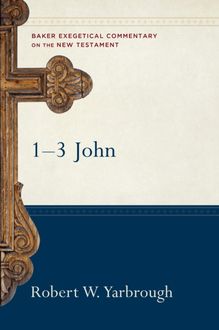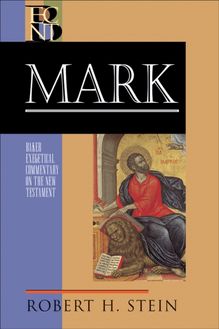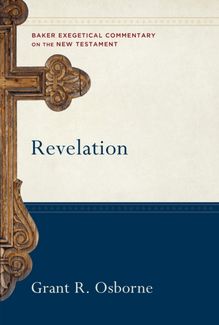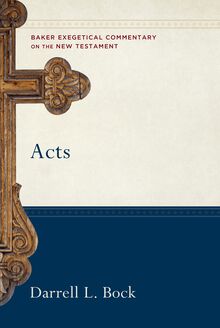Revelation (Baker Exegetical Commentary on the New Testament) , livre ebook
760
pages
English
Ebooks
2002
Vous pourrez modifier la taille du texte de cet ouvrage
Obtenez un accès à la bibliothèque pour le consulter en ligne En savoir plus
Découvre YouScribe en t'inscrivant gratuitement
Découvre YouScribe en t'inscrivant gratuitement
760
pages
English
Ebooks
2002
Vous pourrez modifier la taille du texte de cet ouvrage
Obtenez un accès à la bibliothèque pour le consulter en ligne En savoir plus
Publié par
Date de parution
01 novembre 2002
Nombre de lectures
0
EAN13
9781441200969
Langue
English
Poids de l'ouvrage
3 Mo
Publié par
Date de parution
01 novembre 2002
Nombre de lectures
0
EAN13
9781441200969
Langue
English
Poids de l'ouvrage
3 Mo
Series Page
BAKER EXEGETICAL COMMENTARY ON THE NEW TESTAMENT
ROBERT W. YARBROUGH and JOSHUA W. JIPP, EDITORS
Volumes now available:
Matthew David L. Turner
Mark Robert H. Stein
Luke Darrell L. Bock
Acts Darrell L. Bock
Romans, 2nd ed. Thomas R. Schreiner
1 Corinthians David E. Garland
2 Corinthians George H. Guthrie
Galatians Douglas J. Moo
Ephesians Frank Thielman
Philippians Moisés Silva
Colossians and Philemon G. K. Beale
1–2 Thessalonians Jeffrey A. D. Weima
James Dan G. McCartney
1 Peter Karen H. Jobes
1–3 John Robert W. Yarbrough
Jude and 2 Peter Gene L. Green
Revelation Grant R. Osborne
***
Grant R. Osborne (1942–2018; Ph.D., University of Aberdeen) was professor of New Testament at Trinity Evangelical Divinity School, Deerfield, Illinois. In addition to Revelation, he wrote commentaries on Matthew, Mark, John, and Romans and a textbook on hermeneutics and contributed numerous articles to scholarly journals and essay collections. He also served on the Bible translation committee for the New Living Translation.
© 2002 by Grant R. Osborne
Published by Baker Academic a division of Baker Publishing Group P.O. Box 6287, Grand Rapids, MI 49516–6287 www.bakeracademic.com
Ebook edition created 2012
Ebook corrections 02.22.2019, 03.21.2022
All rights reserved. No part of this publication may be reproduced, stored in a retrieval system, or transmitted in any form or by any means—for example, electronic, photocopy, recording—without the prior written permission of the publisher. The only exception is brief quotations in printed reviews.
Library of Congress Cataloging-in-Publication Data is on file at the Library of Congress, Washington, DC.
ISBN 978-1-4412-0096-9
Baker Publishing Group publications use paper produced from sustainable forestry practices and post-consumer waste whenever possible.
To my mentors:
Wes Gerig Richard Longenecker Clark Pinnock I. Howard Marshall
My deepest appreciation for taking the rough granite of my life and sculpting what I am today
Contents
Cover
Series Page
Title Page
Copyright Page
Dedication
Map
Series Preface
Author’s Preface
Abbreviations
Transliteration
Introduction to Revelation
I. Prologue (1:1–8)
II. Churches Addressed (1:9–3:22)
A. Inaugural Vision (1:9–20)
B. Letters to the Seven Churches (2:1–3:22)
III. God in Majesty and Judgment (4:1–16:21)
A. God’s Sovereignty in Judgment (4:1–11:19)
B. Great Conflict between God and the Forces of Evil (12:1–16:21)
IV. Final Judgment at the Arrival of the Eschaton (17:1–20:15)
A. Destruction of Babylon the Great (17:1–19:5)
B. Final Victory: The End of the Evil Empire at the Parousia (19:6–21)
C. The Thousand-Year Reign of Christ and Final Destruction of Satan (20:1–10)
D. Great White Throne Judgment (20:11–15)
V. New Heaven and New Earth (21:1–22:5)
A. Coming of New Heaven and New Earth (21:1–8)
B. New Jerusalem as the Holy of Holies (21:9–27)
C. New Jerusalem as the Final Eden (22:1–5)
VI. Epilogue (22:6–21)
Works Cited
Index of Subjects
Index of Authors
Index of Greek Words
Index of Scripture and Other Ancient Writings
Notes
Back Cover
Series Preface
The chief concern of the Baker Exegetical Commentary on the New Testament (to be known as BECNT) is to provide, within the framework of informed evangelical thought, commentaries that blend scholarly depth with readability, exegetical detail with sensitivity to the whole, attention to critical problems with theological awareness. We hope thereby to attract the interest of a fairly wide audience, from the scholar who is looking for a thoughtful and independent examination of the text to the motivated lay Christian who craves a solid but accessible exposition.
Nevertheless, a major purpose is to address the needs of pastors and others involved in the preaching and exposition of the Scriptures as the uniquely inspired Word of God. This consideration affects directly the parameters of the series. For example, serious biblical expositors cannot afford to depend on a superficial treatment that avoids the difficult questions, but neither are they interested in encyclopedic commentaries that seek to cover every conceivable issue that may arise. Our aim, therefore, is to focus on those problems that have a direct bearing on the meaning of the text (although selected technical details are treated in the additional notes).
Similarly, a special effort is made to avoid treating exegetical questions for their own sake, that is, in relative isolation from the thrust of the argument as a whole. This effort may involve (at the discretion of the individual contributors) abandoning the verse-by-verse approach in favor of an exposition that focuses on the paragraph as the main unit of thought. In all cases, however, the commentaries will stress the development of the argument and explicitly relate each passage to what precedes and follows it so as to identify its function in context as clearly as possible.
We believe, moreover, that a responsible exegetical commentary must take fully into account the latest scholarly research, regardless of its source. The attempt to do this in the context of a conservative theological tradition presents certain challenges, and in the past the results have not always been commendable. In some cases, evangelicals appear to make use of critical scholarship not for the purpose of genuine interaction but only to dismiss it. In other cases, the interaction glides over into assimilation, theological distinctives are ignored or suppressed, and the end product cannot be differentiated from works that arise from a fundamentally different starting point.
The contributors to this series attempt to avoid these pitfalls. On the one hand, they do not consider traditional opinions to be sacrosanct, and they are certainly committed to do justice to the biblical text whether or not it supports such opinions. On the other hand, they will not quickly abandon a long-standing view, if there is persuasive evidence in its favor, for the sake of fashionable theories. What is more important, the contributors share a belief in the trustworthiness and essential unity of Scripture. They also consider that the historic formulations of Christian doctrine, such as the ecumenical creeds and many of the documents originating in the sixteenth-century Reformation, arose from a legitimate reading of Scripture, thus providing a proper framework for its further interpretation. No doubt, the use of such a starting point sometimes results in the imposition of a foreign construct on the text, but we deny that it must necessarily do so or that the writers who claim to approach the text without prejudices are invulnerable to the same danger.
Accordingly, we do not consider theological assumptions—from which, in any case, no commentator is free—to be obstacles to biblical interpretation. On the contrary, an exegete who hopes to understand the apostle Paul in a theological vacuum might just as easily try to interpret Aristotle without regard for the philosophical framework of his whole work or without having recourse to those subsequent philosophical categories that make possible a meaningful contextualization of his thought. It must be emphasized, however, that the contributors to the present series come from a variety of theological traditions and that they do not all have identical views with regard to the proper implementation of these general principles. In the end, all that really matters is whether the series succeeds in representing the original text accurately, clearly, and meaningfully to the contemporary reader.
Shading has been used to assist the reader in locating salient sections of the treatment of each passage: the introductory comments, the discussion of structure, and the concluding summary. Textual variants in the Greek text are signaled in the author’s translation by means of half-brackets around the relevant word or phrase (e.g., ⌜ Gerasenes ⌝ ), thereby alerting the reader to turn to the additional notes at the end of each exegetical unit for a discussion of the textual problem. The documentation uses the author-date method, in which the basic reference consists of author’s surname + year + page number(s): Fitzmyer 1981: 297. The only exceptions to this system are well-known reference works (e.g., BAGD, LSJ, TDNT ). Full publication data and a complete set of indexes can be found at the end of the volume.
Moisés Silva
Author’s Preface
The purpose of this commentary is not only to provide the reader with exegetical and background information on the text but to help the reader trace the theological threads that tie the book together. Therefore, there is a great deal of intertextual data in the book, and on key words I provide the reader with an overview of the term and related terms throughout the Apocalypse (I use “Apocalypse” and “Revelation” interchangeably for variety) along with theological commentary on the theme in the book.
Also, I want to make this a resource so that students can know where scholarship divides on key issues. Thus I often have fairly lengthy lists of scholars with the various options on an exegetical debate. When I do so, I do not name the date and page number on which their view will be found, unless there is only one to a view or it is an article where the page number is needed (then I follow the standard author-date format). The reason is twofold: (1) in commentaries it is easy to find where a view is stated by looking up the discussion of the relevant verse, and (2) it would be unnecessarily long and tedious to place all those dates and page numbers in a list of (at times) ten or twelve names. It clutters up the page and intimidates the reader.
I have so many people to thank that it is difficult to know where to begin. First, I wish to thank Trinity Evangelical Divinity School for giving me a sabbatical for this project. I also appreciate the kin












